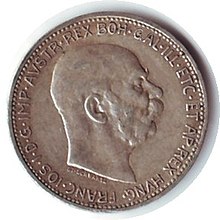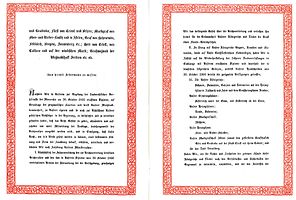Great title of the Emperor of Austria
The Grand Title of the Emperor of Austria was the official listing of the crowns, titles and dignities that the four Emperors of Austria wore from the establishment of the Empire in 1804 until the end of the monarchy in 1918. It goes back to Franz I , who specified it in the imperial proclamation of August 11, 1804.
Composition and importance
The Austrian ruler was not only Emperor of Austria and - since the Compromise of 1867 - particularly prominent in front of other royal titles - Apostolic King of Hungary , but held a rulership title for each individual crown land and a number of other titles. All of these honors were summarized in the so-called Great Title - incidentally not complete there either, as can be seen from the correct indication with the "etc." in several places.
Like the imperial double-headed eagle , the imperial coat of arms, the Austrian imperial crown , scepter and orb, as well as the imperial court with its court ceremonies , the grand title understood itself as an expression of the God-given (and therefore irrevocable) monarchical power and prestige that spanned their country.
Some titles - like most of the dignities related to Italy, for example the Grand Duke of Tuscany - were only used as entitlement titles after the battles of Magenta and Solferino in 1859 at the latest . Others, like the title of King of Jerusalem , were only included in the Grand Title for historical reasons, namely as an inheritance from the Hohenstaufen via the kings of Naples to the Habsburgs. The titles of the Counts of Habsburg and Kyburg refer to the original possession of the Habsburgs, which had been in Switzerland since the early 15th century (the Habsburgs were lost in 1415, the Kyburg pledged in 1424) and were never again owned by the Habsburgs. Lorraine also refers to the family origins of the male founder of the House of Habsburg-Lothringen . Although Archduke of Austria , led by the Emperor, was an actual sovereign title (namely over the present-day federal states of Lower Austria , Upper Austria and Vienna ), this title was at the same time the birth title of all princes and princesses of the imperial house.
The grand title had to be memorized by all school children in Austria at the time of the monarchy.
The great title
The great title of Franz Joseph I was as follows since January 29, 1869:
-
His Imperial and Royal Apostolic Majesty
- NN
- by God's grace Emperor of Austria ,
- King of Hungary and Bohemia , of Dalmatia , Croatia, Slavonia , Galicia, Lodomeria and Illyria ;
- King of Jerusalem etc .; (1)
- Archduke of Austria ;
- Grand Duke of Tuscany and Cracow ;
- Duke of Lorraine , Salzburg , Steyer , Carinthia , Carniola and Bukowina ;
- Grand Duke of Transylvania , Margrave of Moravia ;
- Duke of Upper and Lower Silesia , of Modena , Parma , Piacenza and Guastalla , of Auschwitz and Zator , of Teschen , Friuli , Ragusa and Zara ;
- Prince Count of Habsburg and Tyrol , of Kyburg , Görz and Gradisca ;
- Prince of Trient and Brixen ;
- Margrave of Upper and Lower Lusatia and in Istria ;
- Count of Hohenems , Feldkirch , Bregenz , Sonnenberg etc .; (2)
- Lord of Trieste , of Cattaro and of the Windische Mark ;
- Greater Voivodeship of the Voivodeship of Serbia
- etc., etc. (3)
-
His Imperial and Royal Apostolic Majesty
- (2)“Hohenems, Feldkirch, Bregenz, Sonnenberg etc.”, that is the Kronland Vorarlberg
- (3) “Etc.” is the common phrase used in titulatures for other unnamed titles
In the two years from his proclamation of the Austrian Empire in 1804 to his resignation of the Roman-German imperial crown (of the Holy Roman Empire, which he declared to be no longer existing ) in 1806, Emperor Franz held the great title with the beginning of the grace of God chosen Roman emperors, at all times several of the empire and king in Germania .
Until October 3, 1866, the title also included that of King of Lombardy-Veneto .
With the last emperor Karl I it starts with "Karl the First" and after "King of Hungary" follows in each title ", this name the fourth."
Reuse
After 1918, the great title was used as a historical reminiscence at two Habsburg burial ceremonies in Vienna .
At the burial of the last Empress, Zita , on April 1, 1989 in the imperial crypt, before the gate was opened and the coffin carried into the crypt, a spokesman appointed by the family asked three times to let the deceased be admitted. The first request began with the feminine form of the grand title and highlighting the actual coronation of her husband: "Zita, the Empress of Austria, crowned Queen of Hungary, Queen of Bohemia, ..." In the case of the Duchess titles, the Habsburg title to Parma was omitted, because she had a closer bond. Zita's father Robert of Parma was the last Duke of Parma from 1854 to 1860 and she claimed to be a princess, although not born until 1892. At the end of the list of titles, “ Infanta of Spain, Princess of Portugal and Parma” was added.
Zita's son Otto von Habsburg was asked to enter the crypt on July 16, 2011: "Otto of Austria, once Crown Prince of Austria-Hungary, Royal Prince of Hungary and Bohemia, ...". King of Jerusalem and Archduke of Austria have been omitted from the list of titles. (No emperor of Austria was actually ruler over Jerusalem; from the beginning it was a historical title used only for reasons of prestige. Otto had renounced any claims to rule in Austria in 1961 against the Republic of Austria.)
The middle and the minor title, different titularities

In addition to the major title , which goes down to the rule , there was also the intermediate title and the minor title , abbreviated versions of the title, and the ranking can also be changed a little more appropriately.
- The middle title ends with the "Prince Count of Habsburg and Tyrol". Even before that, individual rulers were missing, but the “King of Hungary” changed to “ Apostolic King of Hungary” after the coronation and an additional “King of” came before Bohemia, since apostolic does not apply here.
- The minor title either enumerates the most important kingdoms and ends with "Archduke of Austria" (until the beginning of 1868) or after the emperor only contains (twisted) "King of Bohemia etc. and Apostolic King of Hungary."
In addition, there was the numismatic clause “ (NN) DGIMP.AUSTR.REX BOH.GAL.ILL.ETC.ET AP.REX HUNG. "(In Hungarian " (NN) IKACS.ÉS MHSDOAP.KIR. "For" Isten kegyelméből austriai császár és Magyar-, Horvát-, Szlavon-, Dalmátországok apostoli királya "), as he on guilders as well as the crown (until 1892 ) (until 1918 ) can be found.
In personal dealings with other monarchs and other high nobility, the emperor made no use of the great title, except for documents. Business cards that were enclosed with gifts to other monarchs were simply labeled with Franz Joseph; High nobility opposite with Emperor Franz Joseph. If necessary, recipients could have the titles looked up in the court and state handbook of the Austro-Hungarian monarchy .
See also
- Austrian Empire (the state 1804–1867)
- Austria-Hungary (the dual state 1867-1918)
- Emperor of Austria (function and owner)
- Austrian imperial anthems
- Titulature and coat of arms of the German emperors after 1873 (comparative)
literature
- Franz Gall: Austrian heraldry. Böhlau, Vienna 1992.
- Franz Ferdinand Schrötter: From the titles and Reicherzämtern of the most transparent ore house of Austria. Provided with an appendix of documents . Kraus, Vienna 1762 ( digitized version ) - on the history of individual title components
Web links
- State handbooks 1808-1917 with the respective titles, (in the genealogical directory 1808: large; 1816: medium; 1817–1847: minor claim to power; from 1868 all three titles after the title page; from 1910 all three titles under court)
- Austria-Hungary: Apostolic King (Hungary), Habsburg Titles. In: Royal Styles. heraldica.org, January 18, 2007, accessed June 23, 2008 . - with the Latin versions, quoted by Gall 1992
- The highest pragmatic regulation of August 11, 1804 (patent of August 11, 1804, PGS Vol. 22 No. 20.) In: Otto Posse: The seals of the German emperors and kings. Volume 5, Supplement 2, page 249f , on Wikisource - last title of a Roman-German emperor, German and Latin wording in Franz I./II.
- Decree of August 6, 1806 on the resignation of the imperial government. In: Otto Posse: The seals of the German emperors and kings. Volume 5, supplement 3, page 256ff - first title of the sole emperor of Austria Franz I.
Individual evidence
- ^ Ernst Trost, That stayed from the double eagle , dtv, Munich 1969, p. 360
- ↑ Weblinks: Habsburg Titles - heraldica.org
- ↑ Peace treatise between his k. k. Apostolic Mayesty and His Majesty the King of Italy from October 3, 1866. Section 116 Imperial Law Gazette for the Austrian Empire. Born in 1866. LXIX. Piece. October 14, 1866.
- ↑ z. B. State Handbook 1902

